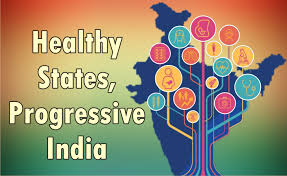Healthy States, Progressive India: NITI Aayog’s Health Index 2019
NITI Aayog has released the 2nd edition of report titled “Healthy States, Progressive India: Report on Rank of States and UTs”. The report has been prepared in collaboration with Union Ministry of Health and Family Welfare along with technical assistance from World Bank.
The current edition of health index accounts for period 2015-16 (base year) to 2017-18 (reference year).
Key Findings of Report
Categories: The ranking was done under 3 categories so as to ensure comparison among similar entities.
1. Larger states– Kerala has emerged as top ranking state while Andhra Pradesh and Maharashtra emerged as 2nd and 3rd best states in terms of overall health performance respectively. While Haryana, Rajasthan and Jharkhand are top 3 ranking States in terms of annual incremental performance.
UP and Bihar, finished at bottom of List. Bihar occupied 2nd last position in ranking of 21 large states while UP stayed static at bottom of rankings.
2. Smaller states– Mizoram was ranked 1st followed by Manipur on overall performance. While Tripura followed by Manipur were ranked top two states in terms of annual incremental performance. Sikkim and Arunchal Pradesh had biggest decrease in overall Health Index scores.
3. Union territories (UTs)- Chandigarh ranked 1st in overall performance of Health India, while Dadra and Nagar Haveli improved most among UT’s. Sikkim and Arunchal Pradesh had biggest decrease in overall Health Index scores.
Empowered Action Group– contains 5 states namely, Bihar, Uttar Pradesh, Uttarakhand, Madhya Pradesh and Odisha which saw decline in overall Health Index score between base year and reference year due to deterioration of performances of several indicator.
Indicators: The decline is attributed to deterioration of performances of several indicators such as total fertility rate (TFR), low birth weight, sex ratio at birth, TB (tuberculosis) treatment success rate, quality accreditation of public health facilities, time taken for NHM (National Health Mission) fund transfer etc.
Positive Correlation: was found between Health Index scores and economic development levels of States and UTs as measured by per-capita Net State Domestic Product (NSDP).
Wide Gap between Performances: Among large states, overall Health Index score of best-performing state is more than 2.5 times that of overall score of least-performing state. States like Kerala and Tamil Nadu have already reached 2030 Sustainable Development Goal (SDG) target for neonatal mortality rate (NMR), which is 12 neonatal deaths per 1,000 live births.
Suggestions: Centre should spend 2.5% of Gross Domestic Product (GDP) on healt and state governments should increase their spending on health from an average of 4.7% to 8% of their budget (net state domestic product) on health. Currently, India’s health spending is only 1.15-1.5% of GDP.
About NITI Aayog’s Healthy States, Progressive India Report
Background: The 1st edition of Health Index was released in February 2018. It measured annual and incremental performances of states and UTs for period 2014-15 (base year) to 2015-16 (reference year).
Methodology Adopted: Health Index is a weighted composite Index based on indicators in 3 domains – (1) Health Outcomes; (2) Governance and Information; (3) Key Inputs/Processes.
Way Ahead: NITI Aayog is committed towards establishing Health Index as an annual systematic tool so as to propel states towards undertaking multi-pronged interventions to bring better health outcomes.
Month: Current Affairs - June, 2019






